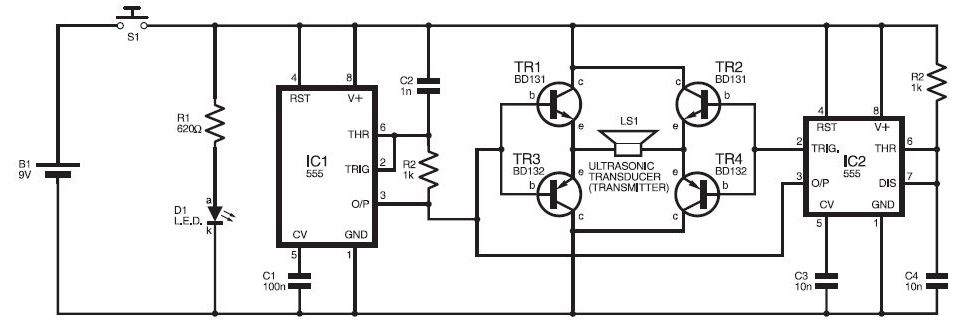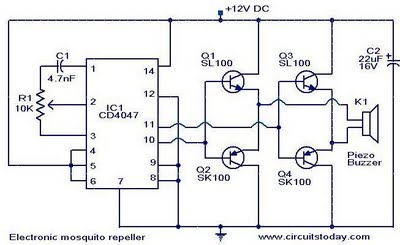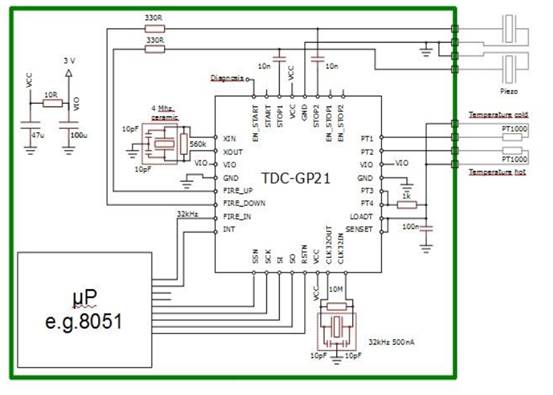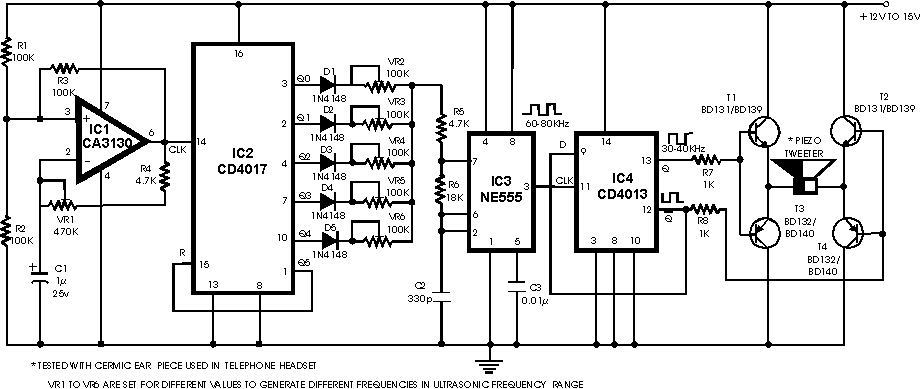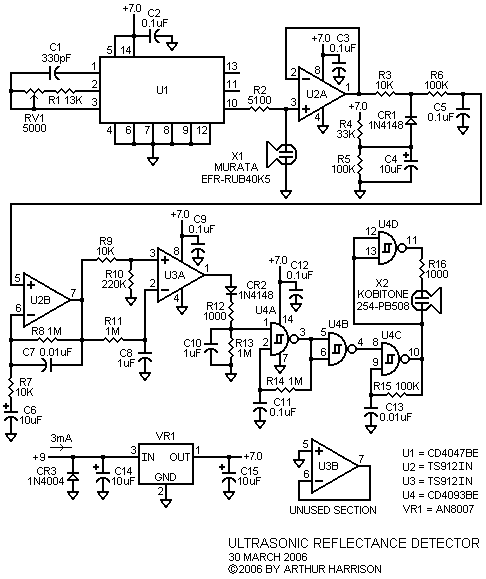
Ultrasonic Dog Whistles
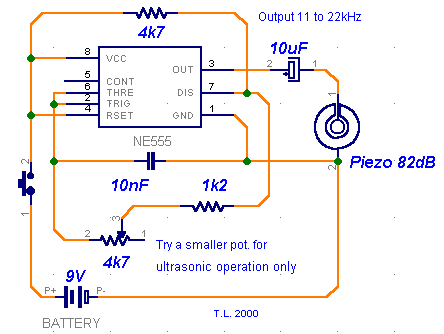
Many commercial pest repellers operate in the frequency range of 30 to 50 kHz. The goal was to design a more powerful audio frequency and ultrasonic sound generator suitable for training dogs. This device could potentially deter dogs from barking at night or help manage aggressive dogs. Research indicates that dogs and similar mammals respond best to frequencies between 15 and 25 kHz, with older dogs being less responsive to higher tones. Consequently, standard pest repellers may not be effective since dogs cannot hear those frequencies. A new circuit was constructed using the classic 555 timer IC, featuring a variable pitch and a loud 82 dB miniature piezo beeper. The circuit is simple and can be assembled in approximately thirty minutes. Most components are non-critical, but variations will affect the operating frequency. A potentiometer is used to adjust the pitch, where higher resistance results in a lower frequency. Since different dogs may react to various frequencies, experimentation is encouraged to optimize the circuit's performance. The circuit relies on a critical 10 nF capacitor, which also influences the frequency. Many ceramic capacitors can be unstable, with tolerances of 20% being common. Higher capacitance leads to lower frequency and vice versa. An oscilloscope is ideal for proper alignment and adjustment, although alternative software like Winscope can be utilized for basic frequency observation. A perf board is sufficient for this project, eliminating the need for a printed circuit board (PCB). Testing the circuit across different frequencies is recommended. A 4.7 kΩ potentiometer combined with a 10 nF (or slightly larger) capacitor can produce frequencies between 11 to 22 kHz, which should be effective. The circuit can be housed in a small plastic enclosure, and an optional LED pilot light can be added. The power consumption is minimal, allowing a 9V battery to last a long time. Future experimentation may include an amplified version of the device for louder output. Previous attempts to enhance high-frequency performance with the 555 timer have not been successful, leading to consideration of a frequency doubler circuit. Another potential project could involve a sound-triggered switch that activates the ultrasonic buzzer when the dog barks.
This circuit design utilizes a 555 timer IC configured in astable mode to generate a variable frequency output suitable for canine training applications. The 555 timer is known for its reliability and ease of use, making it an excellent choice for hobbyist projects. The circuit layout includes a 10 nF capacitor, which is pivotal in determining the oscillation frequency. A potentiometer, typically rated at 4.7 kΩ, allows for fine-tuning the output frequency, enabling the user to adjust the pitch according to the specific sensitivity of different dogs.
The miniature piezo beeper serves as the output transducer, producing sound levels of up to 82 dB, which is adequate for training purposes. The sound pressure level generated by the piezo beeper is significant enough to capture the attention of dogs without being excessively loud for humans. The circuit can be powered by a standard 9V battery, ensuring portability and ease of use.
For assembly, a perf board is recommended to allow for easy modifications and adjustments. The entire circuit can be enclosed in a small plastic box to protect the components and enhance durability. An optional LED indicator can be integrated to signal when the circuit is active, providing visual feedback during operation.
Testing and experimentation are crucial to achieving optimal performance. Using an oscilloscope or frequency analysis software can help in fine-tuning the output frequency and ensuring that the circuit operates within the desired range for effective dog training. The design can be further enhanced by exploring amplification options to increase the output sound level, although challenges with high-frequency performance may require innovative solutions such as frequency doubling techniques.
Overall, this circuit represents a practical approach to creating an audio frequency generator tailored for canine training, combining simplicity with effective performance.Many commercial pest repellers operate in the range of 30 to 50 kHz. My aim was, however, to design a slightly different and somewhat more powerful audio frequency/ultrasonic sound generator that could be used to train dogs. Just imagine the possibilities - you could make your pet think twice before barking again in the middle of the night or even subdue hostile dogs (and I guess burglars would love that!).
From what I`ve read, dogs and other mammals of similar size behave much differently than insects. They tend to respond best to frequencies between 15 and 25 kHz and the older ones are less susceptible to higher tones. This means that an ordinary pest repeller won`t work simply because dogs can`t hear it. Therefore, I decided to construct a new circuit (based on the venerable 555, of course) with a variable pitch and a relatively loud 82 dB miniature piezo beeper.
The circuit is very simple and can be easily assembled in half an hour. Most of the components are not really critical, but you should keep in mind that other values will probably change the operating frequency. Potentiometer determines the pitch: higher resistance means lower frequency. Since different dogs react to different frequencies, you`ll probably have to experiment a bit to get the most out of this tiny circuit.
The circuit is shown below: Despite the simplicity of the circuit, there is one little thing. The 10nF (. 01) capacitor is critical as it, too, determines the frequency. Most ceramic caps are highly unstable and 20% tolerance is not unusual at all. Higher capacitance means lower frequency and vice-versa. For proper alignment and adjustment, an oscilloscope would be necessary. Since I don`t have one, I used Winscope. Although it`s limited to only 22 kHz, that`s just enough to see how this circuit works. There is no need to etch a PCB for this project, perf board will do. Test the circuit to see how it responds at different frequencies. A 4k7 potentiometer in conjunction with a 10nF (or slightly bigger) capacitor gives some 11 to 22kHz, which should do just fine. Install the circuit in a small plastic box and if you want to, you can add a LED pilot light. Power consumption is very small and a 9V battery should last a long time. Possible further experimentation: I`m working on an amplified version of the whistle to get a louder beep.
All attempts so far haven`t been successful as high frequency performance tends to drop dramatically with the 555. Perhaps I could use a frequency doubler circuit - I just don`t know and I`ve run out of ideas. One other slightly more advanced project could be a simple "anti-bark" device with a sound-triggered (clap) switch that sets off the ultrasonic buzzer as soon as your dog starts to bark.
🔗 External reference
This circuit design utilizes a 555 timer IC configured in astable mode to generate a variable frequency output suitable for canine training applications. The 555 timer is known for its reliability and ease of use, making it an excellent choice for hobbyist projects. The circuit layout includes a 10 nF capacitor, which is pivotal in determining the oscillation frequency. A potentiometer, typically rated at 4.7 kΩ, allows for fine-tuning the output frequency, enabling the user to adjust the pitch according to the specific sensitivity of different dogs.
The miniature piezo beeper serves as the output transducer, producing sound levels of up to 82 dB, which is adequate for training purposes. The sound pressure level generated by the piezo beeper is significant enough to capture the attention of dogs without being excessively loud for humans. The circuit can be powered by a standard 9V battery, ensuring portability and ease of use.
For assembly, a perf board is recommended to allow for easy modifications and adjustments. The entire circuit can be enclosed in a small plastic box to protect the components and enhance durability. An optional LED indicator can be integrated to signal when the circuit is active, providing visual feedback during operation.
Testing and experimentation are crucial to achieving optimal performance. Using an oscilloscope or frequency analysis software can help in fine-tuning the output frequency and ensuring that the circuit operates within the desired range for effective dog training. The design can be further enhanced by exploring amplification options to increase the output sound level, although challenges with high-frequency performance may require innovative solutions such as frequency doubling techniques.
Overall, this circuit represents a practical approach to creating an audio frequency generator tailored for canine training, combining simplicity with effective performance.Many commercial pest repellers operate in the range of 30 to 50 kHz. My aim was, however, to design a slightly different and somewhat more powerful audio frequency/ultrasonic sound generator that could be used to train dogs. Just imagine the possibilities - you could make your pet think twice before barking again in the middle of the night or even subdue hostile dogs (and I guess burglars would love that!).
From what I`ve read, dogs and other mammals of similar size behave much differently than insects. They tend to respond best to frequencies between 15 and 25 kHz and the older ones are less susceptible to higher tones. This means that an ordinary pest repeller won`t work simply because dogs can`t hear it. Therefore, I decided to construct a new circuit (based on the venerable 555, of course) with a variable pitch and a relatively loud 82 dB miniature piezo beeper.
The circuit is very simple and can be easily assembled in half an hour. Most of the components are not really critical, but you should keep in mind that other values will probably change the operating frequency. Potentiometer determines the pitch: higher resistance means lower frequency. Since different dogs react to different frequencies, you`ll probably have to experiment a bit to get the most out of this tiny circuit.
The circuit is shown below: Despite the simplicity of the circuit, there is one little thing. The 10nF (. 01) capacitor is critical as it, too, determines the frequency. Most ceramic caps are highly unstable and 20% tolerance is not unusual at all. Higher capacitance means lower frequency and vice-versa. For proper alignment and adjustment, an oscilloscope would be necessary. Since I don`t have one, I used Winscope. Although it`s limited to only 22 kHz, that`s just enough to see how this circuit works. There is no need to etch a PCB for this project, perf board will do. Test the circuit to see how it responds at different frequencies. A 4k7 potentiometer in conjunction with a 10nF (or slightly bigger) capacitor gives some 11 to 22kHz, which should do just fine. Install the circuit in a small plastic box and if you want to, you can add a LED pilot light. Power consumption is very small and a 9V battery should last a long time. Possible further experimentation: I`m working on an amplified version of the whistle to get a louder beep.
All attempts so far haven`t been successful as high frequency performance tends to drop dramatically with the 555. Perhaps I could use a frequency doubler circuit - I just don`t know and I`ve run out of ideas. One other slightly more advanced project could be a simple "anti-bark" device with a sound-triggered (clap) switch that sets off the ultrasonic buzzer as soon as your dog starts to bark.
🔗 External reference
